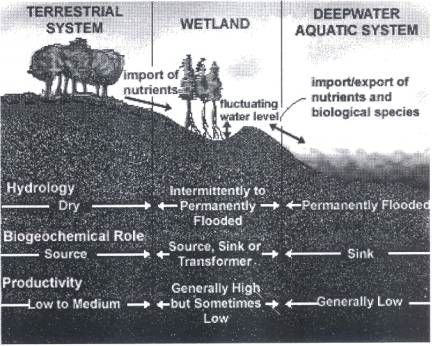AQUATIC ECOSYSTEMS: CATEGORIES
Aquatic ecosystems could be categorised as
1. Open Sea which occupies about 90% of the total surface area of the ocean, and contains about 10% of all marine plant and animal species.
2. Coastal Zone which is the area of the ocean where water depth is less than 200 metres. Within the coastal zone are several unique habitats, such as
- Estuaries-the saline waters of the ocean meet with fresh water from streams and rivers and these habitats are very productive due to accumulation of nutrients from fresh water runoff.
- Tidal marshes-common in temperate areas, and are dominated by sedges and grasses.
- Mangroves-common in tropical areas and have tree species.
- Coral reefs-supported by warm shallow tropical water and comparable with tropical forests in density of individuals, species diversity, and types of life-forms. Corals are tiny organisms that build a calcium carbonate chamber for a home. Over long periods of time, the continued building of these homes creates a large accumulation of coral skeletons (http://www.geog.ouc.bc.ca).
3. Lakes and Reservoirs: Lakes are natural features formed from the accumulation of fresh water in depressions. Sources for the water include precipitation, runoff, stream flow, and groundwater flows while reservoirs are bodies of fresh water that are artificially created by humans. Lakes are categorised according to their nutrient status as:
- Eutropic: rich in nutrients - nitrogen and phosphorous. These have usually large populations of plankton and zooplankton, have less diverse populations of fish, and are often depleted of dissolved oxygen during periods of warm temperatures. Humans have altered the nutrient status of many lakes through the addition of nitrates, urea, and phosphates. This process results in physical, chemical and biological changes in the system. .
- Oligotrophic: these are nutrient poor, often crystal clear and have low biotic productivity.
4. Rivers and Streams: These are created by the accumulation of runoff and groundwater into low lying channels. These constitute important components of the hydrologic system and move water from areas where precipitation exceeds evapotranspiration to lakes and oceans.
5. Fresh Water Wetlands: These are terrestrial habitats that are partially submerged by fresh water and include habitats like marshes, swamps, ponds, etc. These habitats support many different species of fish, birds, and animals. Plants and animals present in wetlands are more than terrestrial habitats, thus making them highly productive environments. Wetlands function as ecotones, transitions between different habitats, and have characteristics of both aquatic and terrestrial ecosystems.
Wetlands have often been described as the kidneys of the landscape because of the role they play in water and chemical cycles. Wetlands filter out sediment and pollution from the surrounding environment so that the water they discharge to rivers and lakes is cleaner. In this manner, wetlands act as both a sink and source, storing and passing on vital resources to their local environment.

Fig. 1 Wetlands: Transition zone between aquatic and terrestrial ecosystems.
|